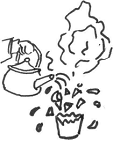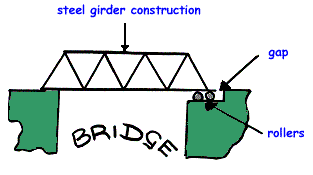Questions on Expansion and Contraction
 Q1.
Q1.
If you pour boiling water straight into an ordinary glass it can shatter.
The only way to do it is to pour the water in very slowly onto a spoon resting within the glass - and even then shattering is very possible!
Use the idea of expansion and contraction to explain why this occurs.
(6 marks)

 Q2.
Q2.
(a) Name a type of glass that does allow boiling water to be safely poured into it - in fact that can be used on a flame to cook with!
(b) How do you think this type of glass differs from ordinary glass to allow this?
(c) How, in school science lessons, will you make use of this type of glassware?
(3 marks)

Q3. Consider this diagram of a bridge over a river.

(a) Briefly explain why you think one end is constructed on rollers.
(b) When would you expect the gap indicated in the diagram to be biggest - in the wintertime or the summertime? (Explain why you think this would be)
(c) What do you think would happen if the bridge had been constructed with no gap? (Give an answer for construction in midwinter and then one for construction in midsummer)
(5 marks)

 Q4. When laying concrete slabs (or brick pavers) in a patio a gap it left between them. This gap is filled with a soft substance such as sand.
Q4. When laying concrete slabs (or brick pavers) in a patio a gap it left between them. This gap is filled with a soft substance such as sand.
Why is this done?
(4 marks)

 Q5. For a given temperature rise, a gas expands much more than a liquid, which in turn expands much more than a solid.
Q5. For a given temperature rise, a gas expands much more than a liquid, which in turn expands much more than a solid.
A bomb makes use of the force produced when rapid expansion of gases occurs.
What do you think would be in danger of happening if you were to leave a half empty bottle of lemonade in the full glare of the sun on a hot summer's day? Explain why you think this might happen.
(3 marks)

Q6. Below is a diagram of a simple fire alarm.

Briefly explain how it works. (Hint: brass expands more than iron when they both undergo the same temperature rise).
(6 marks)

Q7.
(a) What is a thermostat?
A thermostat is used in electric haircurling tongs. Below is a diagram of such a thermostat.

(b) What happens if the tongs gets too hot?
(c) What happens later when the tongs cools again?
(4 marks)

Q8. Below is a diagram of a bimetallic thermometer

(a) From the diagram deduce which metal expands to the greater degree for a given temperature rise; metal A or metal B.
(b) Explain how you reasoned your way to the answer.
(3 marks)




 Q2.
Q2. Q4. When laying concrete slabs (or brick pavers) in a patio a gap it left between them. This gap is filled with a soft substance such as sand.
Q4. When laying concrete slabs (or brick pavers) in a patio a gap it left between them. This gap is filled with a soft substance such as sand.  Q5. For a given temperature rise, a gas expands much more than a liquid, which in turn expands much more than a solid.
Q5. For a given temperature rise, a gas expands much more than a liquid, which in turn expands much more than a solid. 



